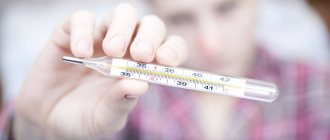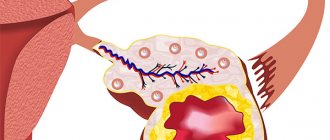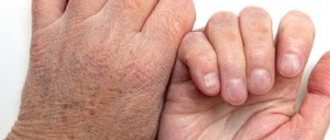Low body temperature in an adult often occurs due to the individual characteristics of the body and does not pose any harm to health. But more often hypothermia is evidence of the development of pathological processes. To return the indicators to normal, it is important to identify the main reason that provoked a sharp decrease in the value.
Prolonged low body temperature indicates the development of the disease
Is low temperature dangerous?
It is generally accepted that normal values on a thermometer are 36.6°C. In fact, readings can fluctuate throughout the day, depending on meals, menstrual cycle and even mood. Therefore, a temperature from 35.5 to 37.0 is considered the absolute norm for each individual person.
True hypothermia, dangerous to health and sometimes life, begins at temperatures below 35°C. If the numbers on the thermometer are between 35 and 36.6 degrees Celsius, then most likely nothing threatens the person’s health.
Pathogenesis
The formation of a state of low body temperature is based on overstrain and disruption of thermoregulation mechanisms, which occurs under the influence of various endogenous/exogenous causative factors. When body temperature drops within 34-36 C, a number of regulatory reactions in the body are included in maintaining temperature homeostasis:
- narrowing of superficial vessels and expansion of blood vessels in the “core” of the body, which allows redistributing the volume of blood in the body towards reducing the volume of blood circulation in the subcutaneous vessels;
- decrease in the volumetric speed of skin blood flow;
- redistribution of heat due to the closure of superficial veins of the subcutaneous tissue and redistribution of blood into deep veins, opening of arteriovenous shunts ;
- decreased sweating;
- an increase in heat production by chemical (metabolism activation) and physical means (muscle tremors, piloerection ).
Can there be a low temperature with coronavirus?
A full-blown infectious process is almost always accompanied by a rise in temperature due to the large number of biologically active substances that enter the blood and have a pyrogenic effect.
This is a kind of protection: at high temperatures, many bacteria, viruses and fungi die. Or at least they begin to reproduce more slowly. But sooner or later, without adequate treatment, a rapidly developing infection leads the body to a state where all defense mechanisms fail.
Can coronavirus cause a low temperature? Yes, if it is:
- Severe conditions: sepsis, acute respiratory distress syndrome, multiple organ failure, disseminated intravascular coagulation syndrome.
- Asthenia after a long viral-bacterial process in the lungs
- Another paradox is low temperature during coronavirus in women over 50 years old
- The safest situation is when the temperature is 1-2 degrees below normal in adults after taking antipyretics against a background of low fever (37-37.5). An antipyretic, designed to reduce temperatures of 38 degrees and above, works effectively, and the temperature drops sharply.
Urgent conditions
These are life-threatening conditions in which low body temperature becomes the result of extensive organ dysfunction and disruption of the constancy of the internal environment of the body. They require resuscitation and treatment in ITAR conditions.
- DIC (disseminated intravascular coagulation syndrome) is a type of hemorrhagic diathesis. At the same time, the coagulation system is strengthened, and multiple blood clots form in small vessels. The result is oxygen starvation of organs and tissues and their dysfunction. At the same time, the risks of poorly controlled external and internal bleeding increase sharply. This leads to decreased blood pressure, metabolic disorders and, as a consequence, hypothermia.
- Sepsis is a systemic inflammatory response to microbial toxins. The developing failure of the cardiovascular, respiratory, urinary, and endocrine systems leads to the fact that elevated temperature and fever are replaced by cooling of the body. Sepsis can result in shock, which often causes patients to die.
- Respiratory distress syndrome is acute respiratory failure against the background of rapidly developing extensive inflammation of the lungs. The release of cytokines leads to massive effusions into the pulmonary alveoli, making gas exchange in the lungs almost impossible. Increasing oxygen starvation slows down metabolism and, as a result, the temperature drops.
Asthenia
A prolonged infectious-inflammatory process depletes the body's adaptive capabilities. Therefore, when viral and bacterial aggression have already been defeated, a person still continues to be haunted by weakness and low temperature. May be observed:
- pallor,
- decreased appetite,
- dizziness, especially with exertion or sudden standing up,
- general loss of strength.
This is a period when additional rest and recovery time is required. It is worth paying attention to adequate sleep, good nutrition, and maximum intake of fresh air.
Postmenopausal women
If menopause becomes a time for women when vascular hot flashes and increases in temperature are not uncommon, then after its end, low levels of estrogens and progestins contribute to a slowdown in metabolism. Age-related involution of the thyroid gland and partial hypothyroidism may also occur. Against the background of infectious viral aggression, in this case the usual rise in temperature does not occur.
Possible complications
Immediate medical attention is critical to prevent complications in the event of frostbite.
Complications include:
- Frostbite, or tissue death, is the most common complication that occurs when body tissue freezes.
- Damage to nerves and blood vessels, resulting in loss of sensation.
- Gangrene or tissue necrosis.
- Hypothermia can also lead to death.
General cooling has a favorable prognosis, and after treatment people usually return to their activities. Deep frostbite affecting large segments of the limbs leads to loss of ability to work and disability.
The modern approach to the treatment of hypothermia in adults guarantees a positive result. Regardless of the cause, doctors are now restoring all neurological functions. The best prognosis is observed if basic medical measures are carried out in a timely manner.
Author: Belyaeva Anna
How to measure temperature correctly?
- In the armpit is the most common method of measuring temperature in our country. It is simple, but also quite inaccurate. So, the norm with this method ranges from 35°C to 37.0°C. In children under one year of age, low-grade fever is considered normal.
- Thermometry in the oral cavity is the norm in Europe and the USA, but rare in Russia. It may also not be effective in children, as they often open their mouth when taking measurements, which is not recommended.
- The rectal method (in the rectum) is very accurate, but is more often used in children. It is not recommended to measure the temperature of newborns rectally (to avoid intestinal damage). The average temperature in the rectum is half a degree higher than the armpit.
- Ear thermometry is popular in some countries, but is highly inaccurate.
Mercury thermometer - to correctly measure the temperature in the armpit, the mercury thermometer must be held for at least 5 minutes.
Hold the electronic thermometer until the beep and check the temperature. Then hold for another minute - if the temperature has not changed, then thermometry is completed. If it has increased further, continue to hold for 2-3 minutes.
The main rule : no need to measure the temperature of a healthy person! This leads to increased anxiety for no reason. If you feel the urge to take your temperature every day, this may be a symptom of depression or anxiety. In this case, you need to consult a psychotherapist.
Folk practice
Perhaps the simplest method to keep warm is a warm bed and dry clothes. But there are other methods that will help change the current situation. What to do if you have hypothermia:
- You can make emergency heating pads by filling plastic bottles with warm water. The water should be warm, not hot, so that you do not have to treat burns on the skin later.
- Place a warm wool blanket on the patient’s chest, put on knitted socks, and place cloth bags filled with hot salt or buckwheat in them.
- Rubbing alcohol will also help warm the human body, but it is important that the person is in adequate condition while doing so.
- For this purpose, ointments made from badger and goose fat are used; such rubbing will help normalize heat exchange.
- Traditional medicine advises giving the patient warm tea with lemon or using chamomile decoction, which has antiseptic properties.
- You can rub the chest and back with garlic infusion with alcohol, and then put the person to bed, putting warm, dry underwear on him.
If there are no means at hand that will help change the current situation, then in addition to the person with hypothermia, 2 more healthy people are placed in bed; they can warm him up with their warmth.
Causes of hypothermia
A significant number of people around the world have an average body temperature that differs from standard norms. Some people see 37°C on the thermometer all their lives, while for others the readings often drop below 36°C. Therefore, hypothermia is a sign of illness only if other symptoms are present. Causes of low body temperature may include:
- previous viral or bacterial infection
- anemia or hidden iron deficiency
- hormonal imbalances - hypothyroidism, diseases of the pituitary gland, hypothalamus
- external influences (frost, prolonged stay in water)
- fasting, dieting
- psoriasis and other extensive skin lesions
- Iatrogenesis (medical actions, drug overdose)
- alcohol and drug use (barbiturates)
- sepsis (blood poisoning)
Hypothermia
Low ambient temperatures cause skeletal muscles to contract.
With the help of cold shivering, the human body tries to fill the energy deficit. Wind and precipitation increase the cooling of the surface. When heat transfer prevails over heat production, the core cools to 35º, and hypothermia occurs. In addition to cold air, the condition is caused by immersion in cold water, skin contact with ice and snow. Note!
Limitation of mobility plays a role. The phenomenon of trench foot is known, when frostbite of tissues occurred in conditions of above-zero air temperatures in soldiers forced to remain immobile for a long time.
Symptoms of hypothermia increase gradually. First, cold shivering is initiated to increase energy production. The muscle fibers of the limbs, head, and torso contract involuntarily. Breathing and heart rate increase. The skin turns red, then turns blue, pales due to sequential expansion and spasm of peripheral vessels. Apathy and drowsiness appear. Disorientation develops, then coma. Against the background of organ dysfunction (bradycardia, ventricular fibrillation, acute renal failure, circulatory failure, breathing) there is a high probability of death. The risks are higher in the elderly and those with limited mobility, whose thermoregulation is imperfect or depressed.
Note:
In case of hypothermia, pale skin combined with drowsiness is a poor prognostic sign that requires immediate pre-medical care. In the open air at zero temperature without movement, death occurs within ten hours.
Past viral or bacterial infection
Any infectious disease, even a very mild one, forces the body to mobilize all its defenses. After illness, recovery occurs gradually. The fever is replaced by low-grade fever (see causes of low-grade fever 37.2 -37.5 C), and then by low temperature. This is accompanied by general weakness, the person feels not fully recovered. This condition may last two to three weeks after the end of the illness.
ARVI
Seasonal viral infections are commonly associated with elevated body temperature, but this is not always the case. The fever usually persists in the first days of the disease, but during the recovery period, many patients suffer from weakness and hypothermia (in the morning the temperature does not rise above 36 ° C), associated with recent stress and a temporary decrease in the body's defenses.
Are you sick? No problem! Oscillococcinum will help your immune system cope with ARVI and influenza.
If you take Oscillococcinum as soon as you notice a deterioration in your health, the drug will be able to stop the development of the disease. There will be no exhausting days with high fever, no sleepless nights due to a stuffy nose, and no forced diet due to a sore throat!
Source: depositphotos.com
Anemia
A low temperature, accompanied by weakness, dizziness and some other symptoms, may indicate a lack of iron in the body. A blood test for hemoglobin, as well as a determination of ferritin, helps to identify this pathology. The main signs of anemia and latent deficiency include:
- Thinning hair
- Striated and brittle nails
- Predilection for raw meat and other unusual tastes
- Inflammation of the tongue
- Weakness and decreased performance
- Pale skin
- Coldness of hands and feet
- Urinary incontinence
After prescribing iron-containing drugs (Ferretab, Sorbifer and others, see iron supplements for anemia), the above symptoms usually disappear within 2-3 months, including chilliness and a decrease in temperature.
Intoxication
Body temperature sometimes drops due to poisoning with chemicals, food (for example, mushrooms) or medications. This is explained by the depression of vital functions (respiration, cardiac activity, etc.) caused by intoxication. The body can react in a similar way to an overdose of alcohol.
Source: depositphotos.com
Hormonal imbalances
The human endocrine system influences absolutely all processes, including thermoregulation. Thus, tumors and brain injuries can cause disruption of the hypothalamus, which in turn is responsible for the temperature of the “core,” that is, a person’s constant internal temperature. Such conditions always clearly manifest themselves as disturbances in consciousness, speech, vision or hearing, problems with coordination, headaches and vomiting. Fortunately, serious brain diseases are rare. Much more often the cause of low thermometer readings is hypothyroidism.
Hypothyroidism is an insufficient functioning of the thyroid gland, a deficiency of its hormones. A similar failure occurs during autoimmune inflammation of the gland, surgery on it, or treatment with radioactive iodine. The disease occurs quite often (according to some data, in 1-10% of the population) and manifests itself with a variety of symptoms:
- Weakness, decreased performance
- Weight gain, swelling
- Chilliness, low temperature
- Dry skin, itching
- Brittle hair and nails
- Drowsiness, memory loss and general lethargy
- Chronic constipation
- Bradycardia (slow heart rate)
To diagnose hypothyroidism, you need to check your TSH (thyroid-stimulating hormone) level. If it is higher than normal, then the likelihood of this disease is high. This is especially true for women over 40 years old whose relatives have problems with the thyroid gland. After diagnosis, the doctor prescribes replacement therapy (Eutirox), which allows you to return to normal health and get rid of symptoms.
Symptoms and signs
Signs of hypothermia appear a couple of hours after exposure to negative factors on the body. After a few more hours, serious disruptions in the functioning of systems and organs occur. After 3–6 hours, death may occur. For these reasons, it is necessary to closely monitor the state of health in order to provide timely assistance to the person.
A decrease in temperature is accompanied by characteristic symptoms that depend on the stage of the pathology:
- Light:
- Tachycardia, rapid breathing.
- Apathy.
- Impaired coordination, orientation in time and space.
- Drowsiness, loss of strength.
- Low or high blood pressure.
- Feeling of trembling in the muscles.
- Middle stage (very dangerous for a newborn baby and a pregnant woman):
- Confused consciousness.
- Attacks of nausea, vomiting, loss of appetite.
- Chills, trembling throughout the body.
- Suspension of metabolic processes.
- Respiratory and heart rhythm disturbances.
- Decreased mental activity, lethargy.
- Severe (requires urgent medical attention, threatens death):
- Absence of tendon reflexes.
- Atrial fibrillation (frequent heartbeat, increased sweating, shortness of breath, dizziness, frequent urination).
- The pupils do not react to light.
- Bradycardia (decreased heart rate).
- Significant reduction in blood pressure.
Iatrogenic hypothermia
Physician-associated hypothermia typically occurs in patients undergoing surgery. If you leave a patient without a blanket after a long surgical procedure, the risk of hypothermia will be high. Anesthesia suppresses shivering, which prevents the temperature from dropping. Therefore, careful attention to postoperative patients is extremely important.
Overdose of antipyretic drugs - quite often, especially in children, the temperature drops sharply after an overdose of antipyretic drugs. Concerned parents, when they see numbers above 38 on the thermometer, begin to actively “bring down the temperature.” The consequences of such actions can be not only disturbances in thermoregulation, but also severe stomach diseases, as well as bleeding. Therefore, under no circumstances should you abuse antipyretic drugs.
An overdose of vasoconstrictor drops is another cause of low body temperature in a child. Due to the general effect on all vessels, such drugs can lead to hypothermia. Therefore, with a normal runny nose, without complications, it is better to rinse the child’s nose with a banal saline solution, sold in any pharmacy.
Seizures are very scary
Seizures that occur in infants and toddlers at high temperatures are called febrile. In this case, the child often loses consciousness, one or more limbs tremble or shake. This can last from 2 seconds to 15 minutes, most often about 2 minutes. Febrile seizures are observed quite often - approximately every 25 children have had them at least once. The mechanism of their development is unknown. Usually they develop at a temperature of about 39°C, but in some people they occur at a lower temperature - these are the ones who need to start lowering the temperature earlier. Although there is no evidence that the use of antipyretic medications reduces the risk of a child developing febrile seizures, if the temperature is above 38.6°C, it is better to reduce it so that the child feels more comfortable and the fever does not increase.
Episodes of febrile seizures do not mean that the child has or will have epilepsy or that he or she needs antiseizure medications. Although sometimes children, especially those prone to febrile seizures, are prescribed anticonvulsant drugs to be taken during fever, as they can reduce the risk of developing a paroxysm.
Febrile seizures do NOT cause any brain damage
However, it is important to tell your doctor about every episode of febrile seizures so your child can be evaluated to make sure he or she does not have a serious condition like meningitis. Children who have had febrile seizures usually do not need hospitalization, but if the seizures persist or there are signs of infection, it is better to admit the child to the hospital and examine
Risk factors for developing febrile seizures:
- The child is often sick with high fever.
- There was a family history of febrile seizures.
- The first occurrence of febrile seizures occurred before the age of 15 months.
Most cases of febrile seizures occur in front of the parents; by the time the doctor gets to the child, the seizures have already passed. In such situation:
- Keep calm. It is most important.
- Place your child on the floor to prevent falling during a seizure.
- Do not restrain or restrain a child who is having a febrile seizure, as this may cause injury.
- If possible, remove any objects or food from the child's mouth, and place him on his side so that he does not choke during seizures.
- NEVER put anything in your child's mouth during a seizure. Objects in the mouth may break and cause choking.
- As soon as the danger has passed, take your child to the hospital or to a physician for further examination to determine the cause of the fever.
After age 5, almost all children outgrow febrile seizures.
Sepsis
The active proliferation of bacteria in the blood and poisoning of the body with their waste products is called sepsis. As with any bacterial infection, with septic complications, a rise in temperature is more often observed, and to very high numbers. But in some cases (in weakened and elderly people), damage to the nervous system occurs, including the thermoregulation center.
In such a paradoxical situation, the human body responds to the invasion of bacteria by a sharp drop in temperature to 34.5°C and below. Hypothermia during sepsis is a rather unfavorable sign. It is combined with a severe general condition, depression of consciousness, and dysfunction of all organs.
THERMAL REGULATION CENTER
The thermoregulation center, called the thermal center, is located in the diencephalon, in the hypogalamic region - in the gray hillock.
If you make an injection into the diencephalon of an animal with a long needle, an increase in temperature occurs. This injection was called a heat injection.
The activity of the thermoregulation center is influenced by two factors: blood temperature and reflex effects. If the temperature of the blood washing the diencephalon is increased, then the telloregulation center is excited, and changes occur in the body’s activity that contribute to a decrease in temperature. When the blood temperature decreases, the heat generation center reacts in such a way that the intensity of the processes that contribute to the increase in temperature increases.
Another method of stimulation is reflex effects.
When exposed to temperature fluctuations on human skin, excitation occurs in the receptors, which enters the thermal center. From there, impulses go to organs associated with heat generation (muscles, liver, etc.) and heat transfer, and cause a change in their activity.
Excitation from the centers of thermoregulation to the organs of heat production and heat transfer is transmitted through the sympathetic nervous system.
Under normal conditions, the process of heat generation and heat transfer is influenced by the cerebral cortex. This follows from experiments performed on animals. In these experiments, a whistle was combined with hanging a 16 kg weight on the dog's back for 15 minutes. The dog's temperature increased by 0.3-0.8° from hanging the load. After several repetitions of this coincidence, the whistle alone caused the temperature to rise.
In another experiment, a dog was placed in a room with a temperature of 22° for several hours; in this environment the dog's temperature increased. A few days later the dog was placed in the same room, but this time the room temperature was 10°. Despite this, the dog's body temperature still increased.
In both the first and second cases, the dog developed a conditioned reflex to increase heat production.
Surveillance was also carried out on freight car conductors, who must stand for hours in cold winter weather in open areas while the train is moving. Studies have shown that they have an increase in heat generation. However, heat generation for these same conductors does not increase if they are not on the road, but on the brake platform of a car in the city or in the courtyard of a laboratory building.
Article on the topic Human body temperature
How to increase the temperature?
First of all, you need to understand whether the decrease in temperature is normal or a deviation from it.
- If you accidentally, just like that, measured your body temperature and found a decrease in it, without experiencing any other symptoms, then calm down. Remember if you have recently had ARVI or another infection. Perhaps these are residual effects.
- Or maybe the reason is the active ventilation of the apartment on a frosty day. In this case, you need to close the windows, dress warmly and drink hot tea.
- If these reasons are excluded, then, most likely, such numbers on the thermometer are your individual feature.
- If, in addition to hypothermia, you experience weakness, depression, or find many other symptoms, it is better to consult a doctor.
Most likely, after additional tests, anemia or reduced thyroid function will be found. Prescribing appropriate treatment will help raise the temperature. In children, it is necessary to discontinue antipyretics and vasoconstrictors.
Tip 2: Osgood-Schlatter disease: symptoms, treatment, consequences
Osgood-Schlatter disease most often occurs in children and adolescents under 18 years of age. As a rule, the cause of this disease is intense physical activity.
Young people who are intensively involved in active sports: football, basketball, athletics, hockey and others are at risk of developing Osgood-Schlatter disease. This disease affects the front of the knee and leads to the destruction of the core of the bone. One of the clear signs of Osgood-Schlatter disease is a fairly large tumor in the knee area.
In most cases, the disease occurs on one leg, but sometimes it can occur on both lower extremities. With timely treatment, the symptoms of this disease may disappear once the child’s body has finished growing.
When is urgent medical attention needed?
Mandatory contact with a specialist is necessary in cases where:
- Man unconscious
- Body temperature is 35°C and continues to decrease.
- Low body temperature in an elderly person combined with poor health
- The presence of serious symptoms such as bleeding, hallucinations, uncontrollable vomiting, speech and vision disturbances, severe jaundice.
Remember that true hypothermia, which is life-threatening, occurs in people who are seriously ill or hypothermic. A slight decrease in temperature will not harm your health. Moreover, at low temperatures all metabolic processes proceed more slowly. Therefore, many experts believe that people with this feature live somewhat longer.
Author:
Evtushenko Anna Aleksandrovna obstetrician-gynecologist
Lifestyle correction
In most cases, incorporating physical activity into your schedule is easy. However, in some cases, for example, with a temporary or permanent loss of the ability to move, people need help from others.
This prevents congestion in tissues and stimulates cardiac activity, thus increasing body temperature.
It will also not be difficult to put your own nutrition in order. It is necessary to abandon sharp restrictions. Nutrition should include carbohydrates, fats, and proteins, as well as vitamins and minerals. Take care of normal water balance. If you are a supporter of therapeutic fasting, consult your doctor; you may have contraindications to this type of healing.
You should also avoid nervous tension and stressful situations. If you notice that you have been prone to depressive thoughts lately, visit your doctor - perhaps the reason for this lies not in a hard life, but in a simple deficiency of B vitamins or Magnesium.











